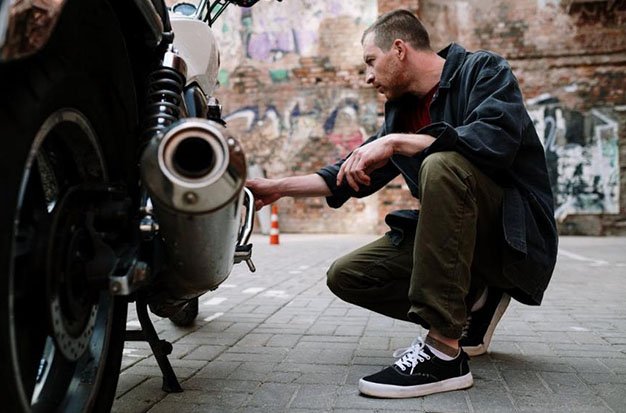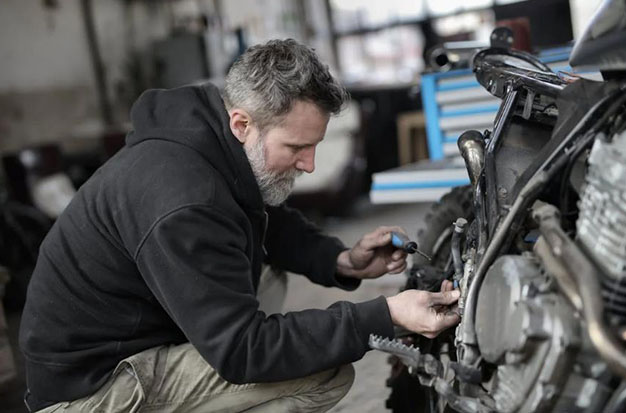You will probably need to bleed your brakes at some point if you ride dirt motorcycles, ATVs, or any other wheeled Powersports vehicle. Even though bleeding brakes is a simple task, there are a few pointers and tricks that can help the procedure go more smoothly and produce better brake performance.
A crucial maintenance step that is frequently skipped is servicing brake systems by replacing worn-out parts as needed and periodically replacing the brake fluid. This article will give an overview of the brake bleeding procedure and offer some advice for making the task simpler. We’ll even offer a few suggestions to help to rebuild your master cylinder go more smoothly.
What Does It Mean To Bleed Your Brakes?
Replace your old brake fluid with new fluid when you “bleed” your brakes. This procedure is required to maintain the proper operation of motorcycles equipped with hydraulic brakes. A valve can be opened to allow you to drain out the old fluid and then add fresh. This keeps the proper operation of your brakes.
The Frequency Of Motorcycle Brake Bleeding
Every two years or so, you should bleed your motorcycle brakes. Increase the frequency of bleeding them if you ride frequently. If you ride frequently, the brake fluid will probably degrade more quickly because it is constantly heated and cooled while you ride.
No matter how little you ride, it’s still a good idea to change your fluid regularly because it will eventually oxidize and get dirty. That said, 2 years is just the recommended interval, if you don’t ride much you may be able to get away with more than that.
The main thing to remember is that bleeding your brakes isn’t a piece of maintenance that should be put off indefinitely. Maintaining brakes ensures that they continue to function properly, which is crucial.
The Reasons Behind Brake Bleeding For Motorcycles
For them to continue to function properly, you should bleed your motorcycle brakes. In order to prevent a drop in braking performance, brake fluid deteriorates over time and needs to be replaced with fresh fluid. You must bleed your brakes if you’re experiencing brake problems or replacing brake components.
Time
Like any fluid within your motorcycle, brake fluid will deteriorate with use and over time. Your brakes may be in perfect working order, but over time the fluid will deteriorate and lose some of its effectiveness. Brake fluid will stop working and possibly even start to harm braking components if it becomes too old or dirty.
Obviously, keeping your brake components functioning as well as possible is very important when it comes to motorcycle safety. Therefore, your brake system’s fluid should be bled and replaced if it hasn’t been changed in a sufficient amount of time.
Braking Issues
Your brakes should also be bled if they don’t appear to be working as well as they should. Most motorcycle brakes, particularly those on more modern bikes, ought to have a sizable amount of stopping power. If the brakes feel unpredictable or like a lot of force is required to use them, there’s probably something wrong.
Changing brake fluid can make a huge improvement in the feel of a motorcycle’s brakes. A motorcycle may occasionally have old or dirty fluid, and it may even have air in the system. Since brakes aren’t always properly bled, any air left in the system will seriously impair stopping power.
The Fluid Looks Dirty
Although at first glance it might not seem like the best justification, there are times when believing what you see is a good idea. Especially if you’ve recently purchased a used bike, you don’t always know when the brake fluid was last changed.
Brake fluid should look pretty clear and not too murky, and definitely free of any debris. It ought to resemble brand-new brake fluid more or less. It’s probably time to change it if it appears cloudy, grubby, or to contain debris.
Installing New Brake Parts
The other reason to bleed your brakes is if you’re changing brake parts. This one won’t always be necessary, but it’s usually a good idea anyhow.
The caliper piston will typically need to be forced open further than it was before a part change, such as replacing brake pads, occurs frequently. As brake pads wear down, the amount of fluid required in the system increases. In order for the pads to make contact with the disc, the piston must push outward ever further.
Brand new brake pads will require less fluid in the system, so installing them may overflow the brake master cylinder if your fluid is at the right level before changing the parts. You could always simply drain the master cylinder of fluid, but since you’re already fiddling with brake fluid, it’s better to simply bleed the system.
Six Easy Steps To Bleed Motorcycle Brakes

Prepare Your Tools And Materials
To bleed your brakes, you’ll need a few different items. You’ll require a small wrench that can fit on the bleeder valve screw. Since you’ll be moving it around a lot, make sure it fits well. You’ll also need a small container to bleed your fluid into and a tube that will fit around (and stay on) your bleeder valve screw.
A container of brand-new brake fluid is also necessary. Make sure to get the right brake fluid for your bike, as there are different types. If the master cylinder cap of the bike doesn’t have the recommended brake fluid listed on it, looking online usually works.
In addition, it is very helpful to have some paper towels or rags on hand to clean up spills. This job is much easier to do if you have someone to help you, although you can usually do it by yourself.
Set Up The Bike For Bleeding
The bleeder valve screw’s rubber nipple must be removed. Put your small wrench on it and then push the tube on top of the hole. Put the tube’s other end in the small container’s bottom. It would be best if you could find an old brake fluid container.
The goal is to avoid accidentally putting any air back into the brake system while bleeding it. You will be adding brake fluid to the master cylinder gradually, so remove the cap from the master cylinder and get your new bottle of brake fluid ready.
Bleed The Brakes
Squeeze the brake lever (or, if applying rear brakes, press the pedal). While keeping pressure on the lever, loosen the bleeder valve screw with the wrench. You ought to notice brake fluid passing through the tube and feel all the pressure leave the system.
Tighten the bleeder valve screw and return the lever to its normal position. Repeat this procedure, adding more fluid as necessary to keep the master cylinder reservoir full. Continue doing this until the liquid leaving the tube resembles the fluid you are putting in the master cylinder.
When you close the bleeder valve the final time, check the feel of the brake lever. Pulling on it ought to feel challenging and firm. If not, there may be air in the system or your bleeder valve may not be completely closed.
Fill The Fluid And Seal The System
Fill the master cylinder reservoir up to the recommended level. Put the cap back on and tighten. A brake system should be tightly sealed because leaks, even at the top of the system, affect how well brake fluid works.
Check again to ensure the bleeder valve screw is tight. Keep in mind that stripping the threads is a real risk because it’s typically a steel screw going into aluminum. The rubber nipple bleeder valve cap should be reinstalled.
Cleanup
You have successfully bled your brakes if you have read this far. Congratulations! Now that your brakes are bled and the system is sealed, it’s time to clean up your work area. Brake fluid is extremely destructive on the wrong surfaces, making this a messy job at times.
Brake fluid can destroy paint and other such things, so make sure there isn’t any excess fluid on your bike. Make sure your bike is clean by wiping everything off with rags or paper towels.
Put the used brake fluid in a container that can be sealed, then get rid of it the same way you would any other chemical. It might be possible to find a place for it at one of the many nearby waste dumps, and some places also hold chemical recycling days. Either way, make sure you dispose of it properly.
Store Leftover Brake Fluid
If there is any extra new brake fluid, seal it up once more and mark the bottle or cap with the date you opened it. It will still work for your bike or any other vehicle for a short while. Most manufacturers say a previously opened container of brake fluid is good for about a year after opening.
Theoretically, the fluid you store should last just as long as the brake fluid you just put in your bike, as they were both opened on the same date. This assumes it is being stored in a reliable container with minimal air leakage. Remember that the fluid’s service life will decrease the longer you wait to use it.
A Few Common Reasons Motorcycle Brakes Won’t Bleed
Your brakes won’t bleed for a few common reasons, which we’ll go over in this article. Clogs in your brake line may result from the brake fluid you are replacing having picked up dirt or debris when it was first installed.
You’ve Got A Lot Of Air In Your Motorcycle’s Brake Line
It may be time to overhaul your brake system if your hand or foot brake lever is soft and failing. If bleeding your brakes has reached the point where no fluid is oozing out, do not panic and be patient! For a number of reasons, a significant amount of air can accumulate in your line over time in an unmaintained brake system.
Water in the brake fluid, worn-out brake pads, faulty master cylinder pistons, or improperly operating brake calipers are all potential causes of air in your line. This can also occur if you or someone else bleeding your brakes unintentionally introduced air into the line.
Even after numerous attempts at bleeding and pressure, nothing has yet to come out. You might only need to apply the brakes and open or close the bleeder valve a significant amount—more than you thought—but, as I said, have no fear. Eventually, the brake fluid ought to begin flowing through the hose and into your excess fluid container, even if you have to wait a while.
If There’s Debris In Your Bleeder Valve, You Need To Remove It
Your bleeder valve ends could be clogged by external debris or corrosion. The fluid, air, or pressure may simply not be coming out of your brakes despite your best efforts to bleed them. You must take out the screws holding the bleeder valve in place and clear any debris that may have become lodged in the channel through which the brake fluid emerges.
It’s not difficult to remove the screws holding your bleeder valve in place, but you should proceed with caution if brake fluid leaks because it can be corrosive, harm paint, and be a pain to clean up.
It’s simple; all you have to do is fully unscrew the bleeding valves. The brake fluid will completely bleed out once you remove them, and you’ll then need to spend some time pressurizing them again.
The bleeder valve will have an inlet hole at one end, and it might be blocked by microscopic debris that got into the system from the outside or by corroded components from an old brake line.
By blowing compressed air through the outlet hole (the portion visible from the outside), you can quickly clear the debris from the inlet hole. If there is any extra debris in the inlet and outlet holes, clean it out using a needle or another thin, hard object.
Use carb cleaner if you have access to it to get every last bit out.
Corrosion Of Old Brake Lines Can Cause Some Serious Stoppage
Every four years, brake lines must be replaced, and every two years, the appropriate fluid must be changed. Aside from contributing to debris-related stoppages, corroded and old lines may also prevent your brakes from bleeding properly or even prevent fluid from reaching the master cylinder.
If you have cleaned the bleeder valve screw and found rust or other gunk inside, fixing the issue now won’t solve the long-term issue, so I advise replacing your brake hose.
Your Motorcycle Brakes Quickly Go Soft And Then Won’t Bleed
Are you certain that there is anything inside if you are trying to bleed your brakes and nothing is coming out?
Check for leaks or ruptures in the reservoir, brake line, master cylinder, pads, and calipers.
It’s likely that air is the only thing left in the brake line to bleed if any component of your motorcycle’s brake system is leaking. Check the brake line’s structure for dings, tears, holes, and other damage. You might just track down the source of your brake-bleeding mystery!
I’ll reiterate that you should replace your brake fluid and line every two years and every four years, respectively. If you wait any longer, you risk having debris and air in your line or, worse, brake failure.
Final Thoughts
Not everyone might want to bleed the brakes on their motorcycle. It can be a messy job, and you’ll have to work with brake fluid, which isn’t the most pleasant substance. That said, I think it’s something anyone with a couple of tools and a positive attitude can easily learn how to do.



